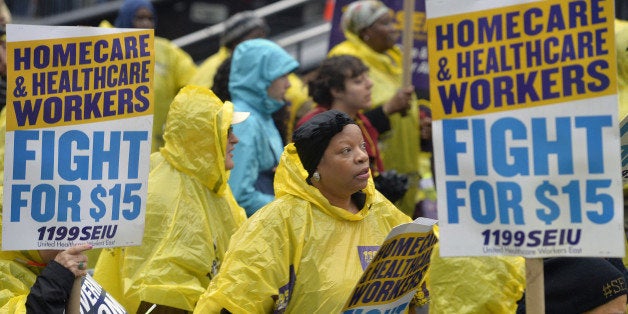
Fewer and fewer working Americans it seems, including many homeowners, are facing the future feeling confident and ready for retirement. There is good reason for such anxiety owing to multiple factors.
Many Americans struggling to make ends meet are seeing the likelihood of living longer than their parents, while earning comparatively less. In many cases, adults are having to support their own offspring and grandchildren through continuing hard economic times.
Communities of color, moreover, are feeling the lingering, disproportionate effects of major losses in their property values and other accumulated assets dating back to the economic meltdown in late 2008. According to the Pew Research Center, between 2010 and 2013, the assets of White households increased slightly by just over 2 percent, while the assets of households of color declined dramatically by comparison; namely, 33 percent for Blacks, and 14 percent for Latinos.
The evidence makes clear that America needs a new deal for people who work (and especially the growing share of people of color who work) who are approaching retirement age--one that can ensure a more robust national economy, wider shared prosperity, and greater economic security for all during the decades to come.
In the past, we have done much better by our working and moderate income families through a combination of increased investment in employee retirement savings and incentives. We learned to strike this balance the hard way, following the worst days ever in our economic history.
Roughly a century ago, when we were in the throes of post-World War I restructuring and the stock market was misleadingly raging in the days just before the Crash of 1929, a secure retirement was only for the wealthy. The overwhelming majority of Americans had to depend on the benevolence of family, friends or religious orders for care in their old age; and even fewer were able to leave any assets to surviving family members.
The Great Depression made it clear that a different approach was necessary--one in which government and private sector institutions would both have to play a significant role in supporting retirement savings and in regulating economic affairs with an eye to avoiding additional economic calamity.
U.S. leaders of the day understood that economic chaos was hardly good for democracy or business in America. Accordingly, private sector pension programs increased 15 percent in the three-year period following the Wall Street meltdown of that era. With additional help from government policy--namely the creation in 1935 of the Social Security Administration--workers continued to benefit from added participation in both private employer-covered pension plans, as well as newly-mandated federal payroll tax deductions for Social Security retirement benefits.
As a result, from 1940 to 1960, the number of people covered by private pensions increased from 3.7 million to 19 million, or to nearly 30 percent of the labor force. By 1975, over 100,000 plans covered 40 million Americans. These benefits in turn were accelerated by Social Security's introduction, which resulted in a doubling of the number of household heads who were able to retire securely during the fifty year period between 1890 and 1940.
These adjustments in retirement support for Americans, coupled with our success in World War II, led to the most significant and longstanding economic boom in U.S. history during the 1950s and 1960s. During this period, the nation achieved an unparalleled degree of economic mobility, shared prosperity, and expansion of the middle class.
These trends began to reverse in the 1970s when a series of global and domestic events led America into a prolonged recession that ultimately altered the political landscape and undercut popular faith in the status quo and especially the role of government in society and the economy.
By the 1980s, more conservative political thinking and trends began to renegotiate the postwar social contract that had led to unparalleled gains and widespread economic security for American workers. This new order resulted in passing on increasing responsibility for retirement savings to individuals.
As a result, pension plans have been significantly declining since 1984, shrinking from over 175,000 active plans across the U.S. in 1983 to only 47,000 in 2008. This is a disturbing trend for Baby Boomers who are now entering retirement age in unprecedented numbers.
This year's presidential election cycle is renewing debate about the government's and the private sector's appropriate roles in shaping U.S. economic and retirement policy for the coming generation. With Social Security presently on course to face insolvency by 2033 and a painfully low savings rate prevailing among Americans, some mighty important decisions lie ahead of us.
The rising cost of living will impact this debate as elders facing retirement in the coming years grapple with profound questions of affordability and quality of life.
Each of the major political parties has strong views on how to address the issues; whatever pathway the nation chooses to take, it is vital that bold new efforts be advanced by progressive and conservative leaders alike to enhance individual and employer incentives to save and invest in a more robust and sustainable retirement system. Without more retirement security America's longstanding social contract will wither and much will be lost.
Key states like California, through its emerging Secure Choice Program, are seeking to increase employer incentives to offer enhanced retirement savings opportunities; and leading private investment companies, like Prudential, are additionally investing in retirement education and empowerment programs that seek to better inform consumers and workers about their financial rights and options in the changing landscape that increasingly confronts all Americans.
Initiatives like these must be advanced to address the growing need for a new 'new deal' for working Americans. Increased retirement investment incentives and options are needed both for America to fulfill its promise to our growing elder population and for elders to have more expendable capital to help drive renewed national economic growth.
- - -
Henry A. J. Ramos is CEO of the Insight Center for Community Economic Development.
